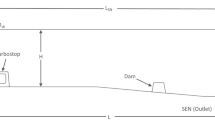Abstract
To evaluate the effect of actual cooling rate of liquid steel in the ladle on the metallurgical performances of a tundish, a transient and coupled computational model was developed to reveal the flow fields, temperature fields, residence time distribution of the molten steel and the inclusion removal efficiency in a typical single-strand tundish with given geometry and process parameters. The results showed that, with the decrease of the ladle stream cooling rate, the temperature difference of bulk flow at the outlet of tundish over a normal casting period decreased from 11. 3 to 2. 6 K, and the dead volume fraction of the tundish decreased from 17. 58% to 14. 35%, while the inclusion removal efficiency was increased especially for the inclusions with the diameter less than 50 μm, whose removal ratio could be increased by 20. 62%. When the cooling rate was less than 0. 3 K · min−1, however, the variation rates of the three evaluation criterions above declined significantly, which suggested that a critical value existed for the effect of the cooling rate of ladle stream on the tundish performances. The establishment of the critical ladle stream cooling rate should be very important to achieve persistent metallurgical properties of tundish over the whole casting stage, together with the reasonable ladle insulation design.
Similar content being viewed by others
Abbreviations
- C d :
-
Coefficient of drag force
- c t :
-
Trace r concentration, %
- d in :
-
Diameter of inclusion, m
- d n :
-
Diameter of submerged entry nozzle, mm
- D eff :
-
Effective diffusivity, m2 · s
- D m :
-
Molecular diffusivity, m2 · s
- D t :
-
Turbulent diffusivity, m2 · s
- F b :
-
Buoyancy force, N
- F d :
-
Drag force, N
- g i :
-
Gravilational acceleration in i direction, m · s−2
- k 1 :
-
Laminar thermal conductivity coefficient, W · m−1 · K−1
- P:
-
Pressure, Pa
- Pr t :
-
Turbulent Prandtl number
- Re:
-
Reynolds number
- Sc t :
-
Turbulent Schmidt number
- t:
-
Time, s
- T:
-
Temperature, K
- t MR :
-
Mean residence time, s
- ui, uj:
-
Liquid velocity in i and j directions, m · s−1
- u in :
-
Velocity of inclus ion, m · s−1
- u m :
-
Velocity of molten steel, m · s−1
- u t :
-
Velocity of tracer, m · s−1
- V D :
-
Dead volume fraction
- V P :
-
Plug volume fraction
- xi, xj:
-
Leng th in i and j dir ections, m
- ε:
-
Turbulence dissipation rate, m2 · s−3
- κ:
-
Turbulence kinetic energy, m2 · s−2
- μeff:
-
Effective viscosity, Pa · s
- μ1:
-
Laminar viscosity, Pa · s
- μt:
-
Turbulent viscosity, Pa · s
- ρ:
-
Density of molten steel, kg ° m−3
- ρ0:
-
Reference density, kg · m−3
- ρ0:
-
Density of inclusion, kg · m−3
References
A. Vargas-Zamora, R. D. Morales, M. Diaz-Cruz, J. Palafox-Ramos, L. Garcia Demedices, Int. J. Heat Mass Transfer 46 (2003) 3029–3039.
S. Ganguly, S. Chakraborty, ISIJ Int. 44 (2004) 537–546.
B. Glaser, M. Görnerup, D. Sichen, Steel Res. Int. 82 (2011) 827–835.
P. R. Austin, J. M. Camplin, J. Herbertson, I. J. Taggart, ISIJ Int. 32 (1992) 196–202.
Y. Pan, B. Björkman, ISIJ Int. 42 (2002) 614–623.
S. Chakraborty, Y. Sahai, ISIJ Int. 31 (1991) 960–967.
S. López-Ramirez, J. De Barreto, P. Vite-Martinez, J. A. Romero Serrano, C. Duran-Valencia, Metall. Mater. Trans. B 35 (2004) 957–966.
R. D. Morales, J. Palafox-Ramos, S. López-Ramirez, J. J. Barreto, D. Zacharias, Metall. Mater. Trans. B 31 (2001) 1505–1515.
Y. Miki, B. G. Thomas, Metall. Mater. Trans. B 30 (1999) 639–654.
X. Huang, B. G. Thomas, F. M. Najjar, Metall. Mater. Trans. B 23 (1992) 339–356.
K. C. Mills, Y. Su, Z. Li, R. F. Brooks, ISIJ Int. 44 (2004) 1661–1668.
S. Kittaka, S. Wakida, T. Sato, M. Miyashita, Nippon Steel Tech. Rep. 92 (2005) 16–21.
H. B. Sun, B. Yan, J. Q. Zhang, in: L. Nastac, L. Zhang, B. G. Thomas, A. Sabau, N. El-Kaddah, A.C. Powell, H. Combeau (eds.), CFD Modeling and Simulation in Materials Processing, John Wiley CV. Sons, Inc., Hoboken, NJ, USA, 2012, pp. 327–334.
Y. Sahai, T. Emi, ISIJ Int. 36 (1996) 667–672.
K.J. Craig, D. J. de Kock, K.W. Makgata, G. J. de Wet, ISIJ Int. 41 (2001) 1194–1200.
A. Kumar, D. Mazumdar, S. C. Koria, ISIJ Int. 48 (2008) 38–47.
Author information
Authors and Affiliations
Corresponding author
Rights and permissions
About this article
Cite this article
Sun, Hb., Zhang, Jq. Effect of Actual Cooling Rate of Ladle Stream on Persistent Metallurgical Performance of a Given Tundish. J. Iron Steel Res. Int. 21, 915–922 (2014). https://doi.org/10.1016/S1006-706X(14)60162-X
Received:
Published:
Issue Date:
DOI: https://doi.org/10.1016/S1006-706X(14)60162-X




